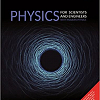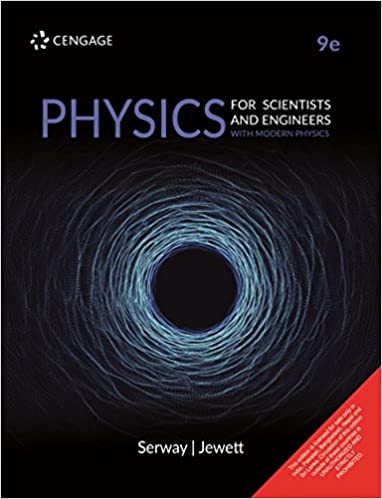Product Specifications
Descriptions
Overview:<br /><br />Achieve success in your physics course by making the most of what Physics for Scientists and Engineers has to offer. From a host of in-text features to a range of outstanding technology resources, you'll have everything you need to understand the natural forces and principles of physics. Throughout every chapter, the authors have built in a wide range of examples, exercises and illustrations that will help you understand the laws of physics AND succeed in your course!<br /><br />Features:<br /><br />Analysis of problems usage data from webassign guided problems. The authors used extensive user data gathered by webassign from professors and students to identify problems that contained muddled or unclear phrasing. The data was used to ensure that the problems professors assigned the most were retained for this new edition. In each chapter's problems set, the top quartile of problems that were assigned in webassign are given an icon for easy identification.<br />&bull; "Watch it" solution videos. Selected problems (indicated in each chapter's problem set with a "w" icon) appear as "watch it" solution videos in enhanced webassign and explain fundamental problem-solving strategies to help students step through the problem. Instructors can choose whether or not to include video hints of problem-solving strategies.<br />&bull; Problem solving strategy. A general problem solving strategy, outlined early in the text, provides a series of steps similar to those taken by professional physicists in solving problems. This problem solving strategy is revisited in each worked example, so students approach problems consistently, developing stronger problem-solving skills. The general problem solving strategy is further reinforced by problem-solving strategy boxes that provide additional tips for tackling specific types of problems.<br />&bull; Worked examples. Always a hallmark of the text, worked examples are presented in a visually appealing two-column format, providing conceptual explanations next to the math for every step. The examples closely follow the authors' proven general problem solving strategy, which is introduced in chapter 2 to reinforce good problem solving habits. About one-third of the worked examples include "what if?" extensions, which further reinforce conceptual understanding. Every worked example can be assigned and graded through the enhanced webassign homework management system. Solutions are presented symbolically as much as possible with numbers substituted in at the last possible moment to help students think symbolically when they solve problems, instead of automatically looking to insert numbers into an equation to solve a problem.<br />&bull; Hallmark problem sets. An extensive set of problems is included at the end of each chapter; in all, the text contains about 3,000 problems. Solutions to selected problems are included in the student solutions manual and study guide (denoted in the text by a box around the problem number) and the answers to odd-numbered problems are provided at the end of the book. The problems set is organized by the sections in each chapter, but within each section, the problems "platform" students to higher-order thinking by presenting all the straightforward (black) problems in the section first, followed by intermediate (blue) problems. The "additional problems" section remains in its usual place, but at the end of each chapter a section of "challenging problems" gathers the chapter's toughest problems in one place.<br />&bull; Problem variety. The authors include a great diversity of problem types, including objective questions (multiple-choice, true/false, ranking) that facilitate students' familiarity with the equations, the variables used, the concepts the variables represent and the relationships between the concepts; conceptual questions; quantitative/conceptual problems which contain parts that ask students to think both quantitatively and conceptually, symbolic problems that ask students to solve a problem using only symbolic manipulation; as well as many problems asking for numerical answers; review problems requiring students to combine concepts covered in the chapter with those discussed in previous chapters and problems that ask students to reason in order-of-magnitude terms. Each chapter also contains at least one problem applying ideas and methods from differential calculus and one using integral calculus.<br />&bull; In-text learning aids. The book includes a summary at the end of each chapter, over 200 "pitfall preventions" in the margins of the text to help students avoid common mistakes and misunderstandings and a wide range of quick quizzes (with answers at the back of the book) that can be assigned and graded through the enhanced webassign homework management system and are also formatted to be used in audience response systems.<br />&bull; A modern, highly unified art program. Every piece of artwork is rendered in an attractive, modern style that helps express the physics principles and ensures that the physical situations presented correspond exactly to the textual discussion at hand. The book's clean and clear visual program helps students understand concepts and facilitates review. In selected figures in the text, "focus pointers" walk students through the often complex figures without having to go back-and-forth from the figure legend to the figure itself. A functional color chart found at the front of the text lists the color-coded symbols used in the text diagrams.<br />&bull; Math appendix. If your students need a quick review of math topics such as algebra and trigonometry, this valuable tool shows essential math concepts in a physics context.<br />&bull; enhanced web assign. Exclusively from Cengage learning, enhanced web assign offers an extensive online program for physics to encourage the practice that's so critical for concept mastery. The meticulously crafted pedagogy and exercises in our proven texts become even more effective in enhanced web assign. Enhanced web assign includes all of the ninth edition's end-of-chapter problems and most of the objective and conceptual questions. Enhanced web assign includes the Cengage you book, a highly customizable, interactive eBook, as well as audience response system content that consists of text-specific "quick quizzes" and "assessing to learn in the classroom" questions developed at the University of Massachusetts at Amherst for advanced conceptual quizzing. Perfect for amateur, intermediate or advanced users of this new learning technology, our platform-neutral content is perfect for use with the "clicker" program of your choice.<br />&bull; Stronger integration of the analysis model approach to problem solving. Because students often find it easier to identify a situation rather than a fundamental principle, this revision highlights the analysis model approach which lays out a standard set of situations that appear in most physics problems and serves as a bridge to help students identify the correct fundamental principle--and then the equation--to utilize in solving that problem. As they gain more experience, students lean less on the analysis model approach and begin to identify fundamental principles directly, more in the manner the physicist does.<br />&bull; New analysis model boxes. To better integrate the analysis model approach, analysis model boxes, which appear at the end of any section that introduces a new analysis model, recap the analysis model just introduced and provide examples of the types of problems that students could solve using the model. These boxes function as a "refresher" before students see the analysis models in use in the worked examples for a given section.<br />&bull; Extensive analysis model reinforcement. Worked examples that utilize analysis models (designated by an "am" icon) thoroughly integrate the analysis model approach in their solutions. The analysis model approach is further reinforced in end-of-chapter summary under the heading "analysis models for problem solving" and through the new "analysis model tutorials" based on the selected end-of-chapter problems that appear in enhanced webassign.<br />&bull; New analysis model tutorials.160 new tutorials written by text co-author john jewett (indicated in each chapter's problem set with an "amt" icon) strengthen students' problem-solving skills by guiding them through the steps in the problem-solving process. Important first steps include making predictions and focusing their strategy on physics concepts before they start to solve the problem quantitatively. A critical component of these tutorials is the selection of an appropriate analysis model to describe what is going on in the problem. This step allows students to make the important link between the situation in the problem and the mathematical representation of the situation. Analysis model tutorials include meaningful feedback at each step to help students practice the problem-solving process and improve their skills. Feedback at the end of the tutorial encourages students to think about how the final answer matches their original predictions.<br />&bull; Annotated instructor's edition. New for this edition, the annotated instructor's edition includes teaching tips and other notes on how best to use the textbook in the classroom. Additionally, the full slate of icons that accompany the various types of problems are included in the questions/problems sets. (The student edition will contain only those icons needed by students.)<br />&bull; New pre-lecture content in enhanced web assign. Updated simulations offer additional parameters to enhance investigation of a physical phenomenon. Students can make predictions, change the parameters and then observe the results. Each simulation comes with conceptual and analytical questions which guide students to a deeper understanding and help promote a robust physical intuition.<br />&bull; New "master its" in enhanced web assign. Approximately 50 of the 376 selected problems that appear as "master its" in enhanced web assign are new for the ninth edition. "Master its" (indicated in problem sets with an "m" icon) help students work through the problems one step at a time.
Specifications
ISBN-13
9789386650672
ISBN-10
9386650672
Cover Type
Paperback
Language
English
No. Of Pages
1583
Author
Raymond A. Serway, John W. Jewett
Publisher
Cengage India Private Limited
Country
India

